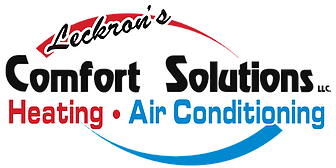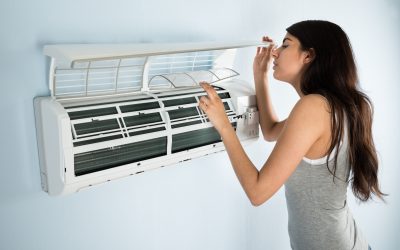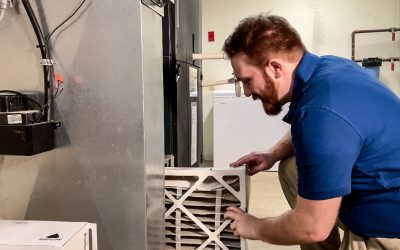Your home’s HVAC system is responsible for air movement. The acronym HVAC stands for heating, ventilation, and air conditioning and covers most items related to heating and cooling air. Thermostats, ductwork, air conditioners, heat pumps, furnaces, air filters, humidifiers, and nearly anything else dealing with moving cooled or heated air falls under the HVAC umbrella.
Although some buildings have separate units for each function, homes often use a combined heating and cooling system. Some homes utilize a combination of central heating with ductless systems for specific areas of the house.
Aside from this aspect of HVAC systems, they are also responsible for ventilation. Ideally, the unit improves your home’s air quality and filters out viruses, dust, mold, pet dander, and other allergens. Furthermore, it enhances the feel of the air by managing humidity levels.
Because your HVAC system constantly monitors your home’s comfort and air quality levels, this is one area you need to be as energy-efficient as possible. The US Energy Information Administration estimates most Pennsylvania families use above 10,000 kWh of electricity annually, spending more than $2,000 on energy bills alone.
Luckily, you can reign in consumption with energy-efficient HVAC systems.
Why upgrade to energy-efficient HVAC systems
You could continue with your current system, making repairs as needed. However, energy-efficient HVAC systems heat, cool, and ventilate effectively and come with additional perks: lower bills, improved air quality, and a more environmentally-sound way to heat and cool your home.
Lower energy costs
FirstEnergy has provided Pennsylvanian families with an energy-efficiency kit. Submit to receive the kit at zero cost to your family. Inside it, you will find LED light bulbs, LED nightlights, a furnace filter whistle, and more.
However, this savings will only take you so far. After that, looking at your HVAC system’s energy efficiency is necessary.
According to Energy Saver, an office of the US Department of Energy, “By switching to high-efficiency air conditioners and taking other actions to keep your home cool, you could reduce your energy use by 20% to 50%.” Lowering your energy use translates to lowering your utility bill.
You may also qualify for a rebate, tax break, or incentive when you upgrade with a qualified energy-efficient model.
Improved indoor air quality
Focusing on indoor air quality is not an overstated hyperbolic concern. The EPA estimates that we spend nearly 90% of our time inside, and the air pollutants are 2-5 times higher than your typical outdoor levels.
This pollution level is undesirable for any person, but it is particularly troublesome for very young, older adults, and anyone with cardiovascular and respiratory diseases such as asthma.
And it’s not going to change anytime soon.
With the current focus on improving building construction to become energy-efficient, there is less opportunity for air to escape in and out of the building. In other words, there are fewer cracks for the polluted air to escape. In addition, indoor pollutants such as synthetic building materials, personal care products, pesticides, and cleaners become trapped inside our homes.
HVAC systems must be ready to filter and clean the air while being both energy-efficient and having high filtration. Utilizing high-efficiency filters has proven highly effective at removing irritant-causing contaminants from the air.
Qualified HVAC technicians can advise homeowners on the best design for energy-efficient HVAC systems, keeping indoor air quality in mind. In addition, they will determine what temperature controls, humidity, and ventilation needs your home requires, as well as which system provides the best options with the lowest energy use.
Reduction in carbon footprint
It is no surprise that our temperatures feel warmer these days. The more each individual does to keep their carbon footprint down, the better our planet will be. There are simple things that can be done, such as changing your filters regularly. While that seems minor, changing your air filter can lower energy consumption by 5% to 15%.
Another easy fix is to set your air temperature higher in the summer and lower in the winter. For example, setting your thermostat at 73 degrees in summer and 67 in the winter drops your bill and saves energy, decreasing your overall footprint.
Adding these measures to the addition of an energy-efficient HVAC is truly where the difference lies. If we moved to energy-efficient air conditioners alone, we could cut 460 billion metric tons of greenhouse gas emissions in four decades. This amount is equivalent to four to eight years of emissions based on 2018 levels. Moreover, as our days get hotter, more AC units will be needed, making the importance of energy-efficient units even more pronounced… so much so that we will need five times more energy than it does today by 2050.
HVAC systems are a significant component in reducing our collective carbon footprint. Often energy-efficient HVAC systems utilize high-efficiency motors and advanced controls.
Furthermore, they can increase their impact by combining with alternative energy sources like solar, geothermal, and wind, diminishing the need for as much fossil fuel reliance and emissions.
Energy-efficient HVAC upgrade options
Once you have decided an energy-efficient HVAC system is the way to go, there are upgrade options to consider. Which upgrades work with your system is something your technicians will cover when evaluating your home’s needs.
Programmable thermostats
We all want to feel comfortable while at home, but we can adjust our thermostat when out of the house. For example, when out of town or at work, having the home at a perfect temperature is an unnecessary expense. When you sleep at night, you can save energy by adjusting the thermostat to temperatures you may otherwise find chilly.
Most people do not have the time to do this daily, but programmable thermostats can. Better yet, these are often pre-set with ideal schedules for turning up or down your temperature settings, giving you a base to start from.
And although this may seem like a frivolous addition, a programmable thermostat has the potential to save 1% energy for each degree you turn down your thermostat. According to ENERGY STAR, this breaks down to around $180 yearly.
Some hints to get the most out of your programmable thermostat are:
- Set your thermostat for energy-saving when you are gone for extended periods, such as work or vacation
- Avoid major and constant changes in temperature
- Try to leave the pre-programmed setting alone as much as possible
- Change temperature an hour before going to sleep and half an hour before waking up
- When you are leaving for more than two days, set a single temperature versus up and down
- Check and change batteries yearly
Some thermostats utilize smart technology. Temperature, humidity, motion, and light sensors record the behavior of home dwellers. Then, the thermostats create a program based on the family’s patterns.
Other smart thermostats use smartphone location data to adjust temperatures. If it reads no occupants are home, it goes into energy savings mode. When a phone is located in the set radius of the home, it automatically adjusts the home’s temperature for arrival.
High-efficiency air filters
It is no secret – when your air filters are old, your system works harder. A clogged air filter requires more energy to push the air through and compromises your system and air quality.
According to the EPA, a high-efficiency air filter “can theoretically remove at least 99.97% of dust, pollen, mold, bacteria, and any airborne particles with a size of 0.3 microns (µm).” Using high-quality air filters takes the load off your air filter. As a result, the fan can run at a lower speed and use less energy.
Note that even with high-efficiency air filters, you still need to change your filter monthly. Any air filter can become overrun with household irritants.
Variable speed air handlers
Instead of the typical HVAC system in which a thermostat causes the system to kick on at 100%, variable-speed air handlers essentially control the compressor and fan motor, cycling on anywhere between 30% to 100%. Because of the reduced speed, the motor uses less energy yet still effectively heats and cools your home.
As you can imagine, flipping a motor from off to full speed uses a tremendous amount of energy, not to mention taking a toll on your fan motor and compressor. Variable speed motors rev up slowly. They start at a lower percentage and build to 100%, effectively extending the life of your system.
A variable-speed motor also helps prevent excess moisture by balancing humidity and temperature. Furthermore, because it starts slowly and runs longer, it filters your air more, translating to decreased allergens for your household.
Geothermal heat pumps
Geothermal means heat produced in the ground. Therefore, geothermal heat pumps are heat pumps that use the earth’s heat for your home. Pipes are located deep in the ground, pulling this heat into your home. Ground heat is relatively reliable, and since the pipes in the ground are not exposed to air or a cooler source, the air temperature stays warm in the pipes as it is delivered to your home. In the summer, it removes the heat from your air in reverse.
Geothermal heat pumps use a heat exchanger to transfer thermal energy from the home and the ground. They also contain a condensing unit to work with the cooling cycle. Finally, a blower moves air into the home.
This type of heat pump ties into heating water, too. In the summer, heat removed from the air is used for warming water for free, and in the winter, the cost of heating water is reduced by around 50%.
Heat pumps use around 25% to 50% less electricity than traditional heating and cooling systems. In addition, the EPA notes geothermal heat pumps reduce energy consumption and emissions by up to 44% and improve humidity controls by 50%.
All these savings translate to lower electricity bills for you. Your HVAC technician will evaluate your home to determine if geothermal heat pumps are an option for the location of your home.
Duct sealing and insulation
The typical home loses 20% to 30% of the air that moves through the ducts. This energy loss is due to leaks, holes, and poorly installed ducts. As one can imagine, poor delivery of warm and cooled air equates to a more expensive monthly bill.
Taking the time to have your ducts examined and ensuring they are adequately sealed and insulated makes your house more comfortable and is easier on your HVAC system – extending its life and saving you money.
When upgrading your duct system, find a technician who:
- Inspects the whole system (ducts, attics, basements, crawl spaces)
- Checks the system’s supply/return air balance
- Repairs damaged/disconnected/tangled/crushed ducts
- Seals leaks/connections/registers/grills
- Insulates ducts in unconditioned areas
- Evaluates air flow after repairs
- Ensures no backdrafting of gas/oil-burning appliances
- Safety tests after ducts are sealed
Government incentives for energy-efficient HVAC upgrades
Installing a whole new HVAC system can cause sticker shock, but before panic takes you away from a worthwhile upgrade, look into government incentives for energy efficiency upgrades to your HVAC system. At both the federal and state levels, incentives are available. Furthermore, with an increased focus on decreasing our carbon emissions, you may find it easier than ever to upgrade your system.
Federal tax credits
On August 16, 2022, President Biden signed the Inflation Reduction Act. This $740 billion climate and health care bill aims to reduce emissions and invest in climate protection
.
The Inflation Reduction Act gives you access to cost-saving options for energy-efficient electric appliances and home improvements. The Act includes benefits for low and moderate-income households installing heat pumps, and there are tax credits for installing specific HVAC equipment.
To learn more about the federal tax credits available for upgrades, visit energy.gov. ENERGY STAR has also provided a detailed breakdown of federal tax credits based on the specific type of HVAC system or source.
State and local rebates
It isn’t just the federal government providing incentives for homeowners wanting to swap out their HVAC systems for something more environmentally friendly.
Depending on the type of home improvement, state tax incentives and rebates are available to you. The Pennsylvania Housing Finance Agency HEELP has loans available to qualified homeowners. FirstEnergy has dedicated a website to helping homeowners find rebates for HVAC upgrades. Additionally, the WARM program can help eligible homeowners identify energy-saving opportunities and receive improvements for their homes.
Navigating the specific rebates and credits available to homeowners can be overwhelming. At Leckrons, we will work to help you capitalize on all savings available to you.
Utility company incentives
Check with your utility company. Some Pennsylvania utility companies have programs, rebates, and energy audits to help homeowners move toward energy savings. These companies are dedicated to providing options for homeowners:
If you need help paying for utilities, check out Pennsylvania Public Utility Commission. In addition, options are available for those in a qualifying bracket or undergoing financial hardship.
Cost-benefit analysis of energy-efficient HVAC upgrades
Making an upgrade is not without costs; the last thing you want is sticker shock or buyer’s remorse. Knowing costs ahead of time prevents surprise price tags.
Initial costs
The exact initial costs depend very much on the type of HVAC system. A new system generally runs anywhere from $3,000 to $12,000. The average is around the $7,000 mark, including installation. Geothermal heat pumps can run significantly higher than the others considering the potential need for extensive digging and highly-specialized equipment.
- Electric or gas furnace: $2,500–$4,000
- Ductless split AC: $3,000–$5,000
- Oil furnace or heat pump: $5,000–$8,000
- Central AC: $5,000–$10,000
- Geothermal heat pump: $15,000–$40,000
- Ductwork: $500-$2,000 or, on average, $10-$20 per linear foot
- Thermostats: $100-$300
Beyond the unit and installation cost, the range of prices for upgrades and your home’s size, layout, and age can drive up costs. Labor will run anywhere from $500 to $3,000. If you add insulation, estimate an additional $1,000-$2,000.
Our technicians can help you estimate your cost based on your home and needs. In addition, they know financing options and seasonal specials that can save on the initial cost of your investment.
Energy savings over time
While the initial cost can be a lot to swallow, replacing your HVAC system with a high-efficiency system can save you massively in the long run.
The US Department of Energy estimates that high-efficiency equipment reduces energy use by 50% for heating and cooling systems and 10% for gas furnace heating systems. They even state, “ENERGY STAR certified heating and cooling equipment, when properly installed, can yield annual energy bill savings of 10-30%.”
Furthermore, when combined with the current tax credits, rebates, and incentives for upgrading your system, there are even deeper savings than these statistics recognize.
Look at a routine inspection plan for your new system to ensure you stay in warranty and keep your system in tip-top shape, running as efficiently as possible.
Return on investment
When you upgrade your HVAC system, you help with energy savings for your family. You enjoy a decreased bill each month and rest more comfortably in temperature-controlled rooms and better-filtered air.
When it comes time to sell your home, consider your return on your investment. Installing a new HVAC system could add 20% -30 % of the cost when you sell your home.
There is also the unaccounted-for value of a new HVAC system – it adds more appeal to your home. Potential buyers will see the value in a new HVAC system knowing they won’t need to replace or upgrade it in the next few years.
Hiring a professional HVAC for energy-efficient upgrades
Once you’ve decided to invest in your HVAC system, you need to know what qualifications to look for in a professional. At Leckrons, we value our customers but also want you to feel comfortable with your decision to use us. Therefore, we recommend these considerations when hiring a professional.
Qualifications
First of all, you must ensure you feel comfortable with the company you select. Read Google reviews and get advice from friends or family who have used them. Ensure they are fully licensed and trained on your home’s system. Verify they have worker’s compensation insurance.
While this isn’t an exact qualification, reputable companies will provide you with a written estimate. Ask about satisfaction guarantees and if there are after-hours, weekend, or holiday service hours.
Some municipalities in Pennsylvania require HVAC licenses or certifications to work on HVAC systems. Check on the requirements of your city.
Questions to ask
Company Questions
- What’s your experience?
- Are you bonded and insured and are your technicians experienced and fully trained?
- Do you offer a free consultation?
- What’s your physical address?
- Do You Have References?
Pricing Questions
- Are your prices competitive compared to other local HVAC companies?
- Do you offer financing/warranties/rebates? If so, what is the process?
- What type of plan options do you provide?
Customer Service Questions
- When is the staff available to answer calls? Is there an emergency line?
- If my HVAC isn’t working, how quickly can I get service?
- If my HVAC needs a part, will I have to wait to get my unit fixed?
- Will you supply customer support if I have any problems or concerns with my new system?
New System Questions
- What new technology is there?
- How efficient is the new system?
- How can I be sure the equipment you recommend achieves the efficiency level you claim?
- Who will supervise/install the installation?
- How long will it take to install the HVAC system?
- Am I getting the best HVAC equipment available?
- Who inspects the system post-work?
- Do you perform ductwork inspections?
- Do you provide maintenance on the equipment you install?
- How frequently should my HVAC equipment be tuned up?
Current System Questions
- What’s wrong with my current HVAC system?
- Can anything be salvaged?
- Do you clean the area after my installation and haul away old equipment?
- Is removal of the old system included in the quote?
Tips for finding the right contractor
To ensure you are finding a reputable contractor, take the time to study your options. Know your current system and its history. Note rooms in your home that are uncomfortable.
Ask friends and family for recommendations and call references. Look for ENERGY STAR-qualified products. Expect the contract to provide a home evaluation and get written, itemized estimates in ink. Look for specific products, model numbers, schedules, and warranties.
Leckron’s: your solution to energy-efficient HVAC upgrades
A lot of ground was covered in this article. From why you should consider an energy upgrade to finding federal and state rebates to expected costs and locating a reputable company – we wanted to give you enough information to feel comfortable investing in an energy-efficient HVAC unit.
You should trust the company you pair with to help you find the best savings and get the most you can for your home. Similarly, you need to know they will help in an emergency and can keep your system in optimal condition.
With Leckron’s, our technicians help you every step of the way. From talking you through the process and listening to your needs, our trained technicians inspect HVAC systems and make recommendations for your home. In addition, they will help navigate various financing options to make your energy-efficient HVAC upgrades a reality.
“Our 46-year-old furnace went out on a Monday morning in February. We called comfort solutions and were able to have a new furnace ordered, delivered, and installed by that Friday. Our house is super warm, and we’re super excited. We decided to go with the complete upgrade with a heat pump to include dual access to our fuel tank when the temperatures drop below 30°; comfort solutions did a fabulous job. We were able to track our technician’s location. They worked quickly and efficiently.” – Shannon B.
With a reliable track record and customers that keep coming back, you can rest assured that Leckrons will make you feel comfortable every step of the way.
So if energy-efficient HVAC systems are on your list of desired upgrades, give us a ring.
Leckrons is here for your HVAC system needs – no matter the humidity or chill Pennsylvania weather brings.
We are excited to help your family see savings right away. Contact us today!




